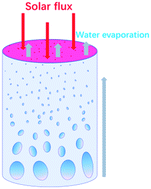Mass production of superhydrophilic sponges for efficient and stable solar-driven highly corrosive water evaporation†
Abstract
Although solar-driven water evaporation has made extraordinary progress for fresh water generation, great challenges still remain in the mass production of photothermal materials, such as low efficiency and stability, for solar-driven highly corrosive water evaporation. The commercial black sponge has the merits of full sunlight absorbability and robust corrosion resistance. Herein, we treated the commercial black sponge with nitric acid to make it superhydrophilic for efficient water evaporation from not only seawater but also corrosive solutions. The superhydrophilic sponge demonstrates a seawater evaporation rate of 2.72 kg m−2 h−1 under simulated 1 sun irradiation, 7.7 times higher than that of the corresponding pure seawater evaporation and exceeding most of the photothermal materials. More importantly, the superhydrophilic sponge displays photothermal water evaporation performances in 0.5 M H2SO4 and 1 M NaOH with stable 2.53 and 2.22 kg m−2 h−1 water evaporation rates, respectively, exhibiting the record water evaporation rates from highly corrosive solutions. We found that the superhydrophilicity of commercial sponges led to a decrease in the latent heat of water evaporation from 2444 to 1081 kJ kg−1, thereby boosting the water evaporation rate. Therefore, superhydrophilic black sponges have great potential for wide industrial applications such as seawater desalination, salt production, brine management and water purification on a large scale.



 Please wait while we load your content...
Please wait while we load your content...